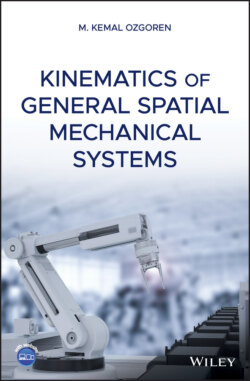Читать книгу Kinematics of General Spatial Mechanical Systems - M. Kemal Ozgoren - Страница 31
2.3 Exponentially Expressed Rotation Matrix
ОглавлениеThe expression of the rotation matrix function , which is given by Eq. (2.17), can be manipulated further as explained below.
Recall that sin θ and cos θ can be expressed as follows by using their Taylor series expansions:
(2.19)
(2.20)
When Eqs. (2.19) and (2.20) are substituted into Eq. (2.17), the Taylor series expansion of is obtained as
(2.21)
On the other hand, as shown in Section, has the following exponentiation properties.
(2.22)
Hence, Eq. (2.21) can be written again as
(2.23)
Note that the series expression on the right‐hand side of Eq. (2.23) is analogous to the Taylor series expansion of the exponential function of a scalar x, which is written below.
(2.24)
Based on the above analogy, the function can be expressed exponentially as
(2.25)
Hence, the rotation matrix can also be expressed exponentially as
(2.26)
Note that the exponential expression of is not only very compact but it also indicates the angle and axis of the rotation explicitly. Therefore, the exponentially expressed rotation matrices can be used quite conveniently in the symbolic manipulations required in the analytical treatments within the scope of rotational kinematics. For the sake of verbal brevity, an exponentially expressed rotation matrix is simply called here an exponential rotation matrix.
